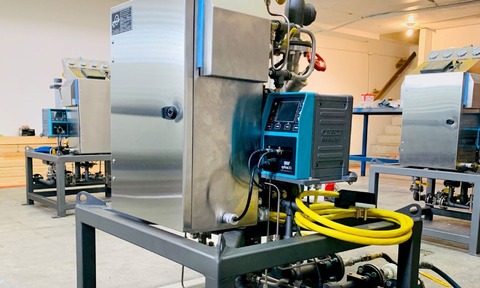Flow technology overcomes a salty problem
10 Nov 2021

When a salt extraction plant ran into production difficulties, Celeros Flow Technology came up with an answer...
Frisia Zout BV produces around 1.2 million tonnes of high quality salt each year, extracting and processing approximately 10,000m3 of brine per day.
The salt extraction process involves boring down into subterranean salt caverns and injecting large quantities of fresh water. This dissolves the salt so it can be pumped back to the surface as brine. The brine then passes through treatment tanks where calcium, magnesium and other contaminants are removed, before a series of evaporation processes are applied to drive off the moisture. Finally, a centrifuge extracts the pure salt.
The existing borehole licence allowed K+S to extract salt from underground on the mainland. Due to regulatory changes, the new government licence would only permit extraction from subsea sources off the coast. Consequently, a new borehole and associated plant was required at their Frisia Zout BV site.
New well, new challenge
Construction began in April 2020 with the aim of bringing it onstream before the existing extraction licence expired at the end of 2021. However, unforeseen difficulties arose with the existing onshore well, which meant that production would cease sooner than anticipated.
Time pressures were not the only challenges the company faced. Due to the natural geology, the extraction route to the new offshore resource was not a straight bore: it changed direction twice before reaching the salt deposits.
In fact, the new plant is fed by one of the deepest wells in the world and has 5km of pipework beyond the water injection pumps. As a result, the process water has to be pumped in at high pressure (250 barg) and at a high flow rate (450 m3/h) to extract the amount of salt required – making the choice of pumps critical to success.
Frisia Zout BV has a long and established relationship with Celeros Flow Technology through the ClydeUnion Pumps brand, based not only on the high quality of their OEM pumps but also on their ability to respond quickly to any operational issues.
Jouk Riemer, project manager for Frisia Zout BV, says: “We have used CUP-BB3 pumps in the past and found that their multistage centrifugal design gives better performance, compared to plunger pumps, for this application. We wanted to use them again for the new project.
Celeros FT assessed the flow requirements for the water injection process at the new plant and verified that CUP-BB3 pumps could be made to meet requirements. The pumps were specified with Duplex stainless steel casings because they would be operating in a salt-laden environment.
ClydeUnion Pumps manufactured and supplied the pump packages, as well as installing and commissioning them. In addition, they supported Frisia Zout BV in bringing an older pump back into service as a spare: assessing it and upgrading the casing to ensure it met the new duty requirements.
The new salt extraction plant came online in December 2020. Its CUP-BB3 pumps meet the high pressure and flow rates required for the application and can run in parallel, which has improved productivity. The availability of a spare pump gives extra confidence that production downtime will be minimal.
Riemer concludes: “This is the first offshore extraction well we have developed: but it has been a largely positive experience, thanks to Celeros Flow Technology. They brought invaluable engineering expertise and specialist pump knowledge to this project and are a fundamental part of its success.”

